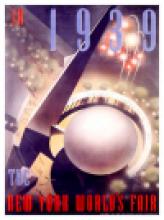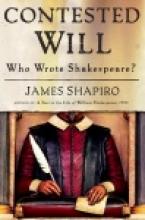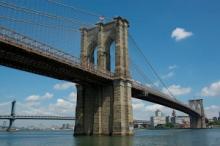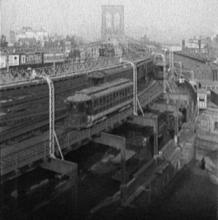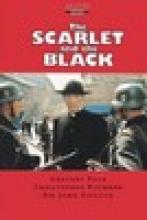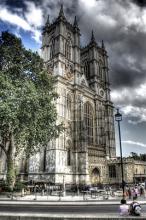Document from 1792 Found in Classroom
Fourth-grade teacher
Michelle Eugenio was cleaning up a classroom in Peabody, Massachusetts when she discovered a small aged document from 1792 that once belonged to one Jonathan Bates. Bates was a Vermonter who served in the Continental Army during the Revolutionary War. The paper is a receipt indicting Bates paid off a debt. You can about it here, and watch the video.Image credit: CNN
Contested Will by James Shapiro
Contested Will.
Simon and Schuster,
N.Y. 2010.
ISBN: 1416541624
Shapiro, a reputable academic and literary scholar with particular expertise in Shakespearean scholarship, opens his preface thus:
This is a book about when and why many people began to question whether William Shakespeare wrote the plays long attributed to him, and, if he didn't write them, who did.
Shapiro conducts an engaging, conversational exploration of the various serious efforts to determine who "the man from Stratford," was, and who wrote the plays of Shakespeare. He begins, logically enough, at the beginning, with the contention of one James Wilmot in 1785, convinced that Francis Bacon wrote the plays. Shapiro explores the main theories and theorists, discovering along the way various frauds, forgeries and cover-ups. I should note, as Shapiro does, that a group of notable people have been convinced that "the man from Stratford" did not write the plays of Shakespeare; these include Henry James and Malcolm X, Sigmund Freud, Charlie Chaplin, Helen Keller, Orson Welles, Mark Twain and Sir Derek Jacobi (this one really surprises me). He engages in fairly thorough discussions of the research and conclusions of Delia Bacon, who first made a serious effort to support Francis Bacon as the author, and the research of J. T. Looney, the first to offer Edward de Vere, the seventeenth Earl of Oxford, as the "real" author.
Alternate contenders favored as a putative author of the plays include Edward de Vere (the Earl of Oxford) and Sir Francis Bacon, though others have been proposed, and Shapiro leisurely looks at the research performed by various people in support of one or another candidate. Shapiro's approach to the question is intriguingly different; his interest in the authorship question is, as he says, "not in what people think--which has been stated again and again in unambiguous terms--so much as why they think it."
This is an engaging, even-handed exploration of the authorship question. Like Shapiro, I am firmly convinced (and have reason for it) that William Shakespeare, late of Stratford-Upon-Avon, the husband of Anne Hathaway and the father of Judith and Hamnet, is the author of the poems and plays, but anyone with interest in Shakespeare at all will find this an engaging exploration. I note that the "Bibliographical Essay" at the end is an extremely useful and well-documented annotated bibliography.
Cinco de Mayo: NOT Mexican Independence Day
Today, the holiday is celebrated across the United States as a day of pride in Mexican heritage. Mexican beer companies make an annual push for sales and people of all backgrounds get drunk and eat Mexican food.Real Californios celebrate with a feast, mariachi music and folkloric dancing. So enjoy the holiday and be cool.
Mexico's Independence Day is September 16, 1810, which marks the day several men spoke against the colonial government of Spain. Battle erupted four days later. 2010 marks the bi-centennial.
In honor of Cinco de Mayo, I deliver to the people a recipe for REAL MEXICAN SALSA, no more Pace Picante Sauce please. It's too easy to make good salsa, to eat bad salsa.
FRESH SALSA (For my white peeps)
3 serrano peppers (diced)
1/2 white onion (diced)
1/4 red onion (diced)
3 tomatos (diced) Keep the juice.
A small bunch of fresh Cilantro leaves (diced!)
Salt, pepper, lime juice if desired
Want Guacamole?
Mash up 3 avocados and dump in half of that salsa. Done.
History Spots: Major Oak
A favorite method of generating cash is to sell acorns from the Major Oak, several people have been cautioned against doing so and internet scams are recorded. In 2003 some 260 oak saplings grown from the Major Oak were planted as part of a national project. The Major Oak is so named because of Major Hayman Rooke, an ex-military man and amateur archeologist, who described the tree in 1790. The Major Oak is on several lists of important historical places and trees, including being named "one of 50 Great British Trees."
Anyone interested in Robin Hood should make a visit to the Major Oak. Much of the economy of the area is based on tourism and people are friendly and proud of their rebelious heritage.
San Jose's Rosicrucian Museum
One part of the museum is dedicated to Egyptian burials and mummification. Several mummies are there, including a youg girl and a man. The young girl's face mask bears the marks of incense poured onto her face over 3,000 years ago by her grieving family. Another section of the museum was dedicated to daily life of the Egyptians. Several pieces that caught my eye were a few heart scarabs that were very intricately carved. Heart scarabs were placed over the hearts of mummies. The scarab beetle is actually what we call a dung beetle today. It was highly regarded beacause of its seemingly magical emergence from the dunes. There is also a section dedicated to Babylonian and Assyrian artifacts. Another interesting collection shows a few artifacts from the Roman era. Under the museum is a replica of a carved out stone temple. A recording explains the paintings on the walls. A free tour was also available from a tour guide.
In all, this museum packs a little punch for its size. The grounds alone are worth a stroll with the Peace Garden and various sculptures, including a nice statue of Julius Caesar. Prices were fair and they offered a AAA discount as well as senior and student discounts.
Brooklyn Bridge
When the Brooklyn Bridge opened in for traffic the first time in May of 1883, it was the longest suspension bridge in the world, half again as large as the next largest bridge, as well as the first steel-wire suspension bridge. It was also, for a while anyway, (by virtue of its towers) the tallest structure in the world. The Brooklyn Bridge it connects the New York City boroughs of Manhattan and Brooklyn by crossing the East River. At the time of its completion, the bridge was the only land-based way to travel between the two boroughs. The construction took eleven years.
Design and construction was originally the work of John Roebling and his son Washington Roebling. But the father injured his foot early in the start of the project, and was unable to continue working on it. He eventually died of tetanus. Washington Roebling took over for his father, and was entirely responsible for it once construction finally began in 1870. But not long after the major construction started, Washington suffered decompression illness (it wasn't even recognized as an ailment at the time, and several of the workers working on the underwater pylons were affected). He was largely incapacitated, and unable to work on the site, and soon, was completely unable to leave his bed. For the last eleven years of the bridge's construction, Washington's spouse Emily Warren Roebling was principal in terms of the design, engineering and mathematic calculations needed to complete the bridge's construction.
The following are all pictures of the bridge; it's still remarkable.
Credit: Irving Underhill; August 11, 1913. Gelatin silver print.
I think that the bridge in the distance is the Manhattan Bridge.
In the undated image below, you can see the towers of the bridge proper, and the approach to the bridge, including railroad and street car tracks.
Image credit: June, 2009 Tiago Fioreze.
"The Scarlet and the Black" (part 1)
Television films often have a bad rep for being low-budget, unremarkable, and possibly even boring, endeavors. Jerry London's 1983 The Scarlet and the Black (based on J.P. Gallagher's novel The Scarlet Pimpernel of the Vatican) shatters that mold, and then some. When you've got actors like Gregory Peck, Christopher Plummer and Sir John Gielgud sharing the screen, you know you're onto something special. The Scarlet and the Black probably won't be ranked highly among their respective resumes, but it will definitely be remembered for their powerful portrayals of real-life people, battling out good and evil in the shadow of the Vatican.
When Nazi Germany captured Italy in 1943, Rome was not spared any of the barbarity that the Germans visited upon the rest of Europe. Under the command of SS Colonel Herbert Kappler (Plummer), Jews were sent to death camps, resistance groups were suppressed, and Allied prisoners-of-war (who had escaped from captivity when Italy surrendered to the Allies) were hunted. Kappler's jurisdiction and de facto power over life and death brought him into conflict with Pope Pius XII (Gielgud), who had to toe the very thin line between resisting the Nazi presence in Rome, and doing nothing that would give the Nazis incentive to overrun the Vatican state. To that effect, Kappler promised that Vatican neutrality would be respected, as long as the Church did nothing to interfere with his activities in Rome.
While Pius XII's hands were tied, Monsignor Hugh O'Flaherty (Peck), an Irish priest serving in the Holy See, organized an enormous network of civilians and fellow priests to rescue and rehabilitate injured and escaped Allied POWs and Jewish refugees. Both Kappler and Pius XII become aware of O'Flaherty's activities: the pope encourages his priest to do the right thing, but not at the risk of exposing the Vatican to Nazi hostility; Kappler promises O'Flaherty that if he is caught outside Vatican territory, he will be shot on sight.
When it comes down to it, The Scarlet and the Black is about two men: O'Flaherty in his robes and modest living quarters, scurrying from safe house to safe house, moving POWs and Jews, offering prayers and strength; and Kappler in his SS uniform, in his lavish office adorned with Nazi standards and portraits of Nazi leaders, or showing his children around museums, proudly proclaiming that the city of Rome is theirs. As their respective worlds collide, the characters change, too. O'Flaherty's Irish pluck is replaced by nightmares, and Kappler recedes into panic and paranoia as his every attempt to capture O'Flaherty (even going so far as to send assassins into the Vatican) is thwarted.
"The Scarlet and the Black" (part 2)
The supporting cast of The Scarlet and the Black - Sir John Gielgud as Pius XII, Walter Gotell as General Max Helm, Raf Vallone as Father Vittorio and Olga Karlatos as Francesca Lombardo - ensure that Plummer and Peck don't carry the movie alone. Gielgud stands out, offering cautious encouragement to O'Flaherty's rescue efforts, while engaging in brinkmanship with Kappler over his priests' diplomatic immunity.
Olga Karlatos carries the burden of being one of the few female leads in The Scarlet and the Black, and she doesn't disappoint. In her, we see how the Italian citizen had to live under the Nazis: she maintains a strong face with O'Flaherty, but she knows that if the Nazis suspect her of subversive activities, she and her daughters will be shot.
On the face of it, the final confrontation between Kappler and O'Flaherty is a bit too Hollywood - the two men facing each other in the dark ruins of the Colosseum. But ironically, that scene probably holds the heart and soul of The Scarlet and the Black. O'Flaherty masterfully proclaims that humanity and goodness will endure, while utterly scorning everything Kappler stood for and represented. Kappler desperately believes in the power of Nazism, even as the SS prepares to evacuate Rome, and slyly demands that O'Flaherty save his wife and children. There's no music, no action, nothing to detract from the image of two men who embody completely opposite ideologies, facing each other one final time. It's a scene for the ages, played by two actors for the ages.
Behind the camera, director Jerry London and cinematographer Guiseppe Rotunno present Rome in all its greatness and mystery. The splendor and magnificence of the Apostolic Palace is contrasted with the shadowy and echoey streets of Vatican City at night, offering a very cerebral viewing experience and paralleling the two main characters - O'Flaherty's beacon of light and hope against the black of Kappler's SS uniform. If not for the archived footage of crowds celebrating the liberation of Rome (and Sir John Gielgud presumably waving to nothing but cameras), the illusion would be perfect and complete. Being a television movie, I imagine London had limited resources at his disposal, but what he does in creating the Rome of 1943 - including the classic opening of two senior SS officers marching through the Apostolic Palace, shiny jackboots and all - is captivating and engrossing nonetheless.
The Scarlet and the Black works on practically every front - Peck and Plummer are ably backed up by their supporting cast, London and Rotunno capture all the subtleties and grandeur of Rome, and Ennio Morricone scores with his oppressive military marches and blend of Gregorian chants. Occasionally, the movie seems incongruously light-hearted - a cute little melody plays while Kappler stares at O'Flaherty through a rifle scope, and sometimes O'Flaherty's jokes and pluck seem out of place - but it's a minor quibble. London and his team offer dramatic and gripping retelling of a priest's successful efforts to save literally thousands of lives under the noses of the greatest evil in history.
Temple to History: Westminster Abbey
A walk through this place is like a walk through all the ages of England. The accessibility of the building is surprising. Considering the greatest treasures of one of the greatest empires ever to exist on Earth are kept there. Among those treasures are the Throne of Edward the Confessor, one of the earliest English kings.
Among the famous burials are the famed and abhorred (in the US) scientist Charles Darwin and another fellow named Sir Isaac Newton. Writers Charles Dickens and Geoffrey Chaucer and actor Laurence Olivier are interred there along with the famed explorer Dr. Livingstone, who is buried without his heart, which lies in Zambia. There are monuments to other great people, like Shakespeare, who aren't buried there. He's buried nearby in Stratford-Upon-Avon.
There is a charge to get in, but if an interest in history is driving a trip to London, this is a must see, THE must see. The cost is 15 Pounds to get in, or about $25.
